It is geared towards a more general audience and so some of the explanations are more simplistic.
I believe there's likely to be some factual errors as well, so please correct any mistakes. In addition, I do not know many of the deities on the pictures below. Please help me identify them. You can write to me separately, quoting the picture numbers, which can be found by moving your cursor over the pictures.
Thanks.
The Inauguration Ceremony of
Jiutiaoqiao Xinba Nadugong Temple, Tampines
Taoist, Malay and Hindu Gods Under A Single Roof
¨C A Bizarre Celebration of Religious Diversity in Singapore
¾ÅÌõ ÇŠà°Ê Äà ¶½ ̳
ÖÚÉñ½ú¹¬Éý×ù´óµä
10 October 2004
Today I attended a most extraordinary ceremony that can only occur in an ethnic melting pot like Singapore - the inauguration ceremony of a suburban Taoist temple known as the Jiutiaoqiao Xinba Nadugong Temple. This is a temple that worships three deities, each representing a deity of the three major ethnic groups (Chinese, Malays and Indians) in Singapore, and whose grand ceremony was celebrated by worshippers from two major faiths (Taoism and Hinduism).
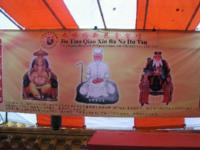 The ceremony banner showing the three deities worshipped in this temple, which also represent the three major ethnic groups of Singapore. From left to right: Ganesha (Indian), Nadugong/Natoh Gong (Malay), Dabogong/Tua Peh Gong (Chinese) | | | 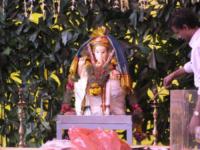 Ganesha, the Hindu elephant god, which is also worshipped here. | | | 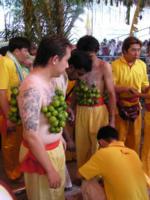 Chinese-Hindus getting pierced Hindu-Thaipusam style | | | 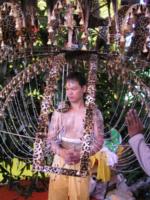 A Chinese Hindu carrying the kivadi | | |
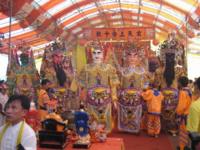 The huge "Da Tou Wa Wa" (literally "Huge Head Dolls") dancing and paying respect to the gods. Mediums possessed by deities wore these enormous costume sets danced along to the ritual music. | | | 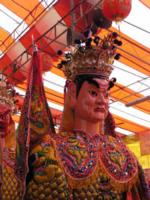 Close-up of a "doll" | | | 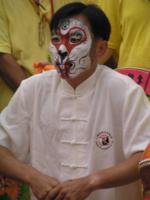 A medium waiting for his turn... | | | 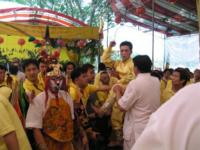 Mediums in possession. Typical "I'm possessed" posture | | |
What is the Nadugong (Äö½¹«)?
When the early Chinese immigrants first arrived in Southeast Asia in the 15th century, they brought along their Taoist gods and deities to these lands. They also realized that to ensure security and prosperity in this foreign land of strange gods and unknown religions, they have to enlist the help of the local gods. ¡°In Rome, do as the Romans do¡±. And so they began worshipping the local gods alongside their own from China.
The Southeast Asia they arrived in was one of polytheistic religions. The earlier Indian traders brought Hinduism and Buddhism, which combined with the local animistic beliefs. Although Islam, the monotheistic religion, first arrived in the 700¡¯s from the Middle East, it did not spread fast until a series of jihads in Java as well as through trade in the 15th century.
Even then, the inhabitants of the Southeast Asian islands and Malay Peninsula retained many of their original animistic and Hindu beliefs. The Chinese immigrants began to worship local pre-Islamic holy men, commonly called Datuk or Dato, meaning ¡°chief¡± or ¡°lord¡± in the Malay language, which soon became known as ¡°Natoh¡± (or ¡°Nadu¡± in standard Mandarin). The suffix ¡°gong¡± which means ¡°lord¡± in Chinese was added to ¡°Nadu¡±, and hence ¡°Nadugong¡±, the amazing Chinese-Malay deity which is found only in Singapore, Malaysia and parts of Indonesia.
In local Chinese religious iconology, the Nadugong is commonly represented by a Malay man dressed in traditional yellow silky Malay shirt and sarong, wearing a formal songkok (hat). Kris (Malay sword) and other traditional Malay court regalia and ceremonial objects would also be placed on the altar, sometimes with images of Islamic holy sites such as the Kabaa of Mecca. Nadugong temples are found across the region, sometimes next to traditional Malay sacred sites where older Malays visit and pray, although it is highly debatable whether these shrines ¨C either the Nadugong or the Malay sacred sites ¨C are really Islamic in any way. Younger Malays, who are more exposed to a global, purist Islam, tend to shy away from such places.
The Jiutiaoqiao Xinba Nadugong Temple
According to Victor Yue¡¯s translation (with some of my additions) of an article from the Shin Ming Daily:
This temple, with a history of 77 years, was originally in Ang Mo Kio, where there were nine bridges, hence, Jiutiaoqiao ¾ÅÌõÇÅ (Nine Bridges), where Tua Pek Kong (Dabogong¡¡´ó²®¹« ¨C a local Taoist deity) and Natoh Gong (Na Du Gong Äö½¹«) were worshipped. [Xinba means ¡°new district¡±]. From the old temple, they moved to the new place at Old Tampines Road. To celebrate racial harmony, Ganesha (the Hindu Elephant God) was included as one of the three main deities to be worshipped in this temple, as a symbol of racial harmony. Twelve decorated Christmas trees would be included.
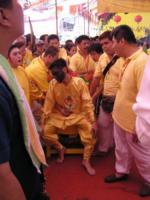 This young medium is getting possessed - he's gyrating his head wildly | | | 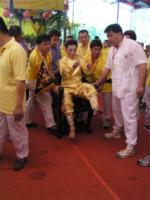 Possessed! | | | 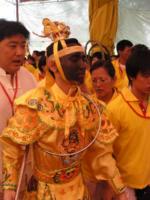 Once possessed, his assistants helped him to get dressed in the full regalia of his deity | | | 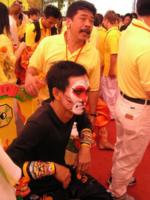 Waiting... | | |
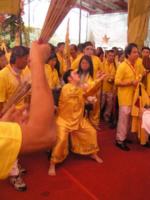 Female medium gyrating wildly upon possessed | | | 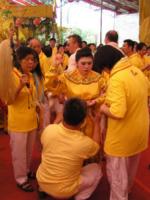 Get pretty | | | 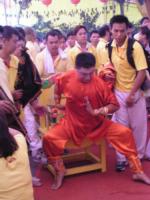 Yes, the god is here too! | | | 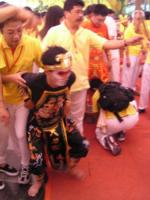 More possessions | | |
The Ceremony
The ceremonies started on Wednesday 6 October 2004, with the bathing of the Ganesha statue with milk, which I didn¡¯t attend. I understand there were also various Taoist rituals conducted by priests specially invited from Fujian, China over the following few days and various charity events organized for fund raising for homes for the elderly.
The main ceremony was on Sunday 10 October 2004. I have been told that 60 spirit mediums (more about spirit mediums at http://weecheng.com/singapore/tanki/story2.htm) from other temples across Singapore would participate in the ceremony. Most folk Taoist ceremonies in Singapore typically include spirit mediums from other temples visiting, getting possessed by their own deities, and paying respect to the temple¡¯s main deities on behalf of their deities, then move on to visit other major temples. Many temples have only one medium while some may have a few more. So this ceremony could well have, say, 30 to 40 temples involved, which is an indication of the funding and influence of this temple. What was equally amazing was the degree of diverse cultural and religious mix that the ceremony involved.
When I arrived at 9:30am in the morning, the whole place was already crowded with hundreds if not thousands of worshippers. Loud Indian drumbeats, Chinese gongs and Taoist ritual music blaring out from loudspeakers ¨C what a weird combination. I walked to the Indian corner of the main tentage. There were a number of Indian altar and statues of various Indian gods (including Durga and Ganesha), surrounded by Indian as well as Chinese worshippers.
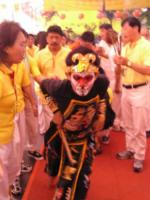 The monkey god is ready! | | | 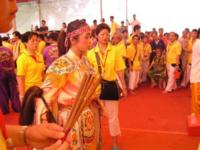 Female medium in front of the altar | | | 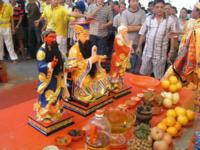 The statues of the Jade Emperor and his heavenly advisors | | | 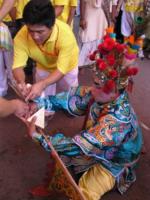 Medium paying respect to the Jade Emperor | | |
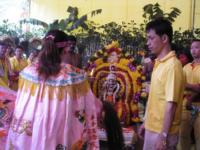 Female medium paying respect to the Hindu goddess | | | 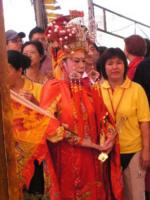 In full regalia - magnificent, isn't it? | | | 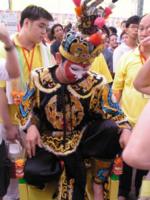 A young monkey god hopping and gesturing on his dragon chair | | | 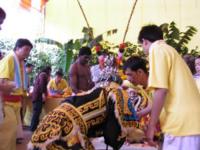 The monkey god bowing to the statue of the Hindu goddess | | |
About six Chinese men were being pierced with huge spikes of kivadis they would soon carry as a sacrificial gesture of piety, helped by Indian worshippers and priests. Kivadis are huge metal cages holding imagery of Hindu gods during Hindu festivals such as Thaipusam, supported by sharp spikes weighing down on the devotees carrying them. An Indian religious band was beating the drums and an Indian lady medium was dancing wildly to the beat, accompanied by a few Chinese women whirling around in sarees! The latter appeared to be possessed as well, sticking out their tongues, painted bloody red, perhaps like the ferocious goddess Kali, Goddess of Dissolution and Destruction. One of them was chewing away handfuls of neem leaves, which are supposedly good for curing skin aliments. A steady flow of Indian worshippers were arriving along with some Taoist worshippers, and all prayed to the various deities.
As the Chinese gongs beat faster, I rushed to the Chinese side of the tentage ¨C there were about nine giant ¡°huge head dolls¡± or Da Tou Wa Wa, dancing around, bowing to the statues of various gods. I have been told that these were actually Taiwanese ritual characters that have become more common in Singapore Taoist rituals in recent years. Some say within these ¡°dolls¡± were mediums who were in trance, possessed by their own gods, and were participating in the ceremonies under the command of their gods. Amazing stuff!
Then the long possession session for visiting mediums began. In groups of three to five, the mediums sat in the ¡°dragon chairs¡± and became possessed. [See http://weecheng.com/singapore/tanki/story4.htm] They would then bowed and prayed to the Taoist gods and deities at separate altars in the tentage before heading for the Indian side to pay respect to the Hindu gods. As there were many mediums involved, it was about two hours before every medium had their turn.
It was an amazing session, as the mediums were possessed by the many gods and deities on the Taoist pantheon ¨C much more than a typical Taoist ceremony seen elsewhere. Apart from the more common Monkey God (ÆëÌì´óÊ¥), Hei Bai Wu Chang (Tua Li Yeh Bo ; ´óÒ¯²® & ¶þÒ¯²®), Third Prince (뻨ÈýÌ«×Ó) and Shan Chai Tong Zi (ÉƲÅï×Ó) , I also spotted Justice Bao, Guan Gong (¹ØÊ¥µÛ¾ý) and many more deities I could not identify. The costumes and rituals were spectacular - I am amazed that the mainstream media in Singapore did not report the event at all and I bet the Tourism Board was not aware of all these happening, even though thousands of Singaporeans and many temple organisations were involved.
One particularly unusual possession ceremony involved two young men representing Tua Li Yeh Bo started by lying down on grass mat, with their heads on stacks of Chinese ¡°hell notes¡± as though they were dead. As the gongs and cymbals beat louder, they began shaking slowly and then gradually getting wilder. Before long, they were rocking wildly and eventually standing up with their deities in control.
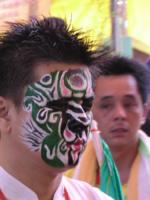 Facial art: When a medium's face is painted, he is not merely trying to look like the deity he represents, his body is taken over by the god himself, who has to ensure that the body he takes over does look like him. | | | 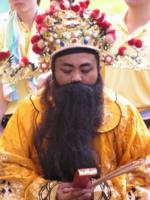 Another medium in the regalia of another heavenly magistrate | | | 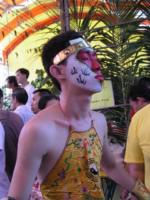 One of the many young mediums at this ceremony | | | 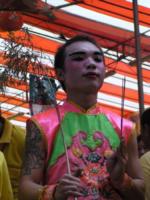 Yet another young medium | | |
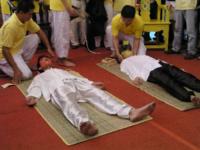 Mediums representing Tua Li Yeh Bo (Hei Bai Wu Chang) - they lie down like dead people to wait for these Hell deities to possess them | | | 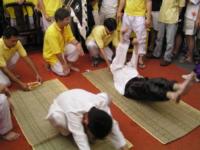 They "turned alive" and rock wildly as the twin Tua Li Yeh Bo deities possessed them | | | 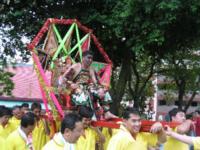 A deity being carried around | | | 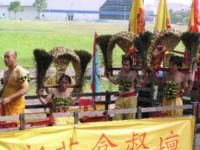 The kivadi carriers getting ready for the temple runs | | |
At about 1pm, everyone was leaving. The mediums and their drum troupes in various lorries, Taoist flags fluttering away, and their followers getting into 40 coaches. The whole convoy set off for Hao Lin Gong Temple (ľºÀÃÖ¹¬) in Ang Mo Kio, another suburban town more than 15km away.
Then the whole process repeated. The Taoist mediums and the Hindu entourage formed a long line and marched into the temple group by group, greeted by the resident mediums. An interesting process of mutual greeting and ritual dances took place, and the visiting mediums bowing and paying respect to the main deities of this temple. Thousands of nearby residents watched the ceremony with curiosity, many snapping away with their digital or cell phone cameras, not to mention thousands of devotees who have followed the whole procession from Tampines.
At this point, I decided to call it a day. The procession would move on to temples in Upper Serangoon, Hougang, Sengang, Pasir Ris and then back to the initial site at Tampines. There would be ritual fire-walking and fireworks in the evening, followed by more rituals. At an auspicious hour close to 11pm, the temple will be declared open, with a few TV stars gracing the ceremony too!
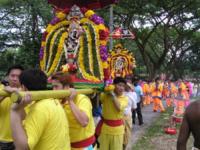 Statues of the Hindu gods being carried around - now in Ang Mo Kio | | | 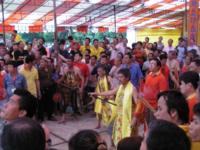 The resident mediums at the Ang Mo Kio Hao Lin Gong Temple | | | 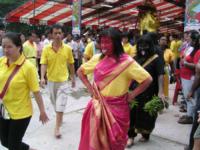 Some female Chinese-Hindu mediums - wearing sari and sticking their tongues out | | | 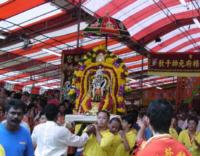 The Hindu goddess leaving Hao Lin Gong Temple | | |




































Comments